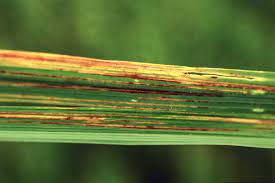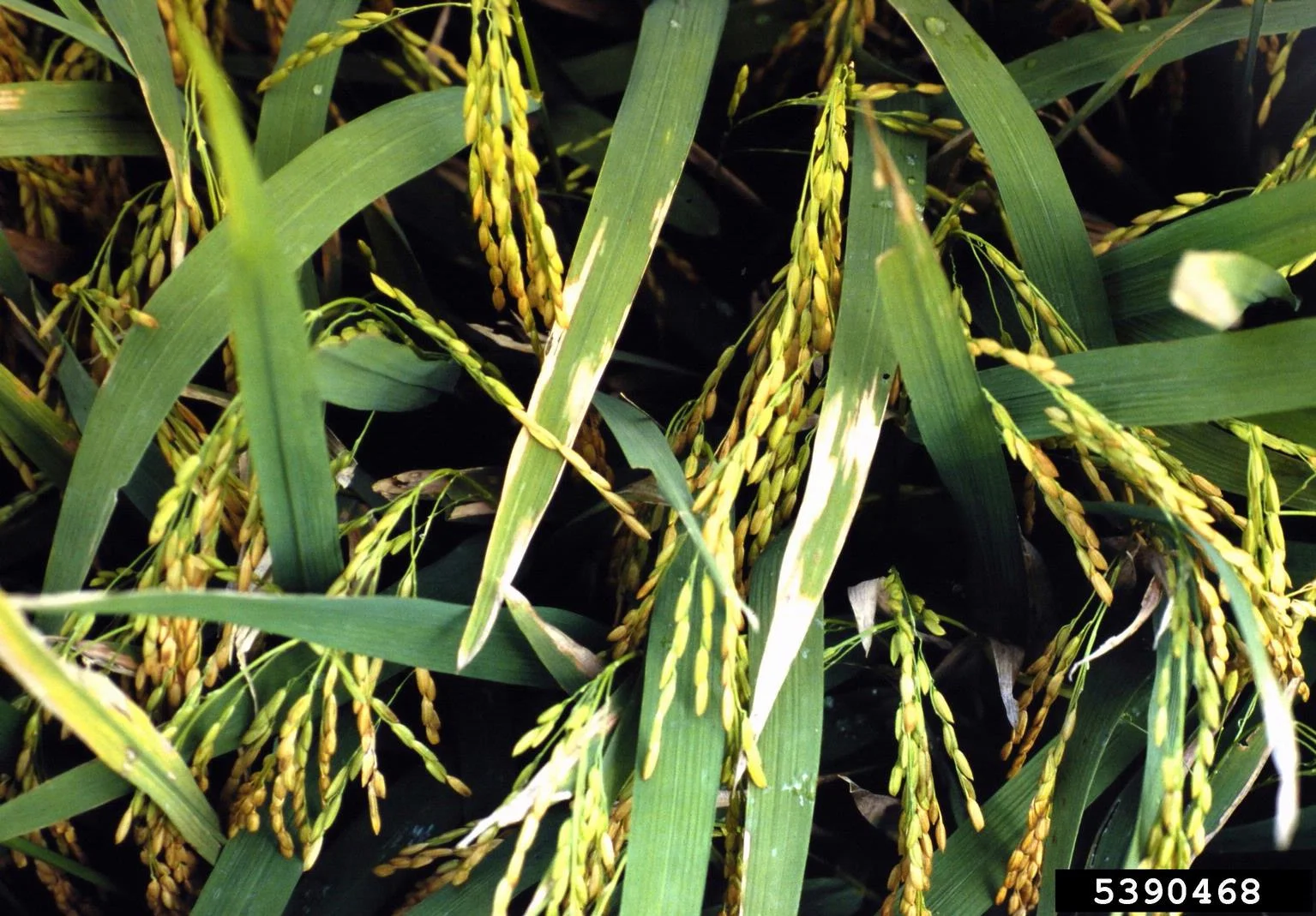| Disease | Bacterial Leaf Blight of Rice |
|---|---|
| Hosts | Rice |
| Pathogen | Xanthomonas oryzae pv. oryzae (Xoo) |
Bacterial leaf blight, also known as bacterial blight of rice, is a highly destructive disease affecting cultivated rice plants. Bacterial leaf blight of rice is caused by the bacterium Xanthomonas oryzae pv. oryzae (Xoo), it poses a significant threat to rice crops worldwide. The disease is characterized by the appearance of water-soaked lesions on the leaves, which gradually turn yellow and then brown.
These lesions can expand and merge, ultimately causing the affected leaves to dry up and die. Bacterial leaf blight can result in substantial yield losses of up to 75% during severe epidemics.
Bacterial leaf blight was first discovered in Kyushu, Japan in 1884-85, and the causal agent, Xanthomonas oryzae pv. oryzae (Xoo), was identified in 1911 under the name Bacillus oryzae.

It is prevalent in warm and humid regions such as Asia, Africa, Australia, Latin America, and the Caribbean. Although not commonly found in the United States, a related bacterial strain has been regulated as an agricultural select agent.
Effective management strategies, including the use of disease-resistant rice varieties, proper field practices, and timely application of bactericides, are essential for controlling bacterial leaf blight in rice crops.
Bacterial Leaf Blight of Rice Symptoms

Bacterial leaf blight (BLB) is a destructive disease that affects rice plants, caused by the bacterium Xanthomonas oryzae pv. oryzae. It is important to recognize the symptoms of bacterial leaf blight to effectively manage and control the bacterial leaf blight of rice. The following are the key symptoms associated with bacterial leaf blight:
Seeding Sysmptoms:
- Observed 1-3 weeks after transplanting.
- Early symptom: A green water-soaked layer along the cut portion or leaf tip of leaves.
- Leaves wilt and roll up, turning grayish green to yellow.
- Entire plant wilts completely.
Leaf Symptoms:
- Small, water-soaked spots initially develop on the leaf blades near the leaf tips.
- Spots gradually enlarge and become elongated lesions with a yellowish-white or grayish color.
- Lesions have a distinct rectangular shape, measuring 1-3 centimeters in length and 0.2-0.5 centimeters in width.
- Lesions may coalesce under favorable conditions, covering larger areas of the leaf surface.
- Progression of the disease leads to necrotic lesions turning brown or reddish-brown, surrounded by a yellow halo.
- Severely infected leaves tend to dry quickly.
- Loss in grain yield may be up to 60%.
Confirmation: To confirm bacterial leaf blight symptoms, the following steps can be taken:
- Squeeze the lower end of the infected seedling between the fingers.
- Look for yellowish bacterial ooze coming out of the cut ends.
- Observe the cut portion against the light to see bacterial ooze streaming out from the cut ends into the water.
- After 1-2 hours, the water becomes turbid.
Sheath Symptoms:
- Infected leaf sheaths develop water-soaked, brownish lesions, often elongated in shape.
- Lesions can extend along the length of the sheath, causing wilting and drying of the affected tissue.
- Severe infection may result in split open sheaths, exposing the stem and leading to plant lodging.
Panicle Symptoms:
- Bacterial leaf blight can extend to the panicles or reproductive structures of rice plants.
- Infected panicles exhibit small, water-soaked spots or streaks on the glumes and awns.
- Spots progress to brown and necrotic, causing withering and death of affected spikelets.
- Infected panicles often have reduced grain set, resulting in lower yields.
Other Symptoms:
- Wilting of infected plants, stunted growth, and general decline in vigor.
- Damping-off symptoms in infected seedlings, leading to their premature death.
- Increased susceptibility to lodging, making the plants more vulnerable to other diseases and pests.
Recognizing and understanding the symptoms of bacterial leaf blight is crucial for effective disease management in rice cultivation. Early detection and appropriate control measures can help minimize yield losses caused by this destructive disease.
Disease Cycle of Bacterial Leaf Blight of Rice and How to Identify It

Identification of the Pathogen:
- The bacteria responsible for bacterial leaf blight of rice are rod-shaped, measuring approximately 1.2 x 0.3-0.5 µm.
- They exist as single cells or occasionally in pairs but not in chains.
- Gram-negative in nature, they do not form spores and lack capsules.
- On nutrient agar, their colonies appear as pale yellow, circular, smooth, and have an entire margin. They exhibit a convex and viscid (sticky) texture.
Factors Favoring Disease Development: Several factors contribute to the development of bacterial leaf blight in rice:
- Presence of weeds in the rice fields.
- Rice stubbles and ratoons from previously infected plants serve as sources of the pathogen.
- Bacteria can be present in the rice paddy and irrigation canals.
- Favorable environmental conditions include warm temperatures ranging from 25-30°C, high humidity, rainfall, and deep water.
- Severe winds causing wounds and over-fertilization are conducive to disease development.
- The bacterium can spread through irrigation water, rain, plant-to-plant contact, and the use of trimming tools during transplanting.
Disease Cycle:
The disease cycle of bacterial leaf blight involves the following stages:
- Inoculum: The pathogen can be present in rice stubble and weed hosts. Although infected seed and soil may contain the bacterium, they are not considered significant sources of inoculum.
- Transmission: Bacterial spread occurs through irrigation water, rain, direct contact between plants, and the use of tools during transplanting. Typhoons can contribute to rapid disease spread.
- Infection: The bacterium enters leaf tissues through natural openings such as hydathodes and stomata on leaf blades, growth cracks formed by emerging roots at the base of the leaf sheath, and wounds on leaves and roots. When bacterial multiplication reaches a certain level, some bacteria invade the plant’s vascular system and may ooze from hydathodes.
- Symptoms and Signs: Bacterial leaf blight exhibits two main sets of symptoms: leaf blight and wilt (known as kresek).
- Survival: Weeds, rice stubble, and ratoons of infected plants serve as sources for the survival of the pathogen. In Australia, the bacterium can also survive on wild Oryza species. Infected seeds and soil have not been proven to be significant sources of inoculum.
By understanding the disease cycle and recognizing the characteristic symptoms, farmers and researchers can effectively identify and manage bacterial leaf blight of rice, helping to minimize its impact on crop productivity.
Management Strategies for Bacterial Leaf Blight of Rice:
Preventing Method:
Izumonas-Best Fungicide
Contents: Pseudomonas Fluorescens
IZUMONAS is a biological product consisting of plant growth-promoting rhizobacteria (PGPR), which are naturally occurring bacteria found widely in nature. This unique product is designed to enhance plant defence mechanisms and promote healthy growth. IZUMONAS can be used on all types of crops without leaving any residue on the plants.
Izumil-Best Fungicide
Contents:
- Extract of Streptomyces griseus: 30%
- Extract of Streptomyces violaceus: 40%
- Dissolving agents: 30%
IZUMIL is a remarkable biotech research product that has been developed to activate the natural defence mechanism of plants. By using IZUMIL, plants can better protect themselves against fungal pathogens, improve their physiological functions, and develop resistance against various harmful microorganisms. Similar to IZUMONAS, IZUMIL can be safely used on all crops without leaving any residue.
Modes of Use:
- Seed Treatment: Mix 5-10 ml of IZUMONAS and IZUMIL per kilogram of seeds in an adequate amount of water. Submerge the seeds in this solution and allow them to dry in a shaded area before sowing.
- Seedling Treatment: Combine 100 ml of IZUMONAS and IZUMIL per 20 litres of water. Dip the roots of the seedlings in this solution for approximately 30 minutes prior to transplanting.
- Soil Application: Mix 500 ml of IZUMONAS and IZUMIL with 30 kilograms of farmyard manure (FYM) or soil. Apply this mixture to one acre of land before ploughing or irrigation.
- Foliar Application: Dilute 2-3 ml of IZUMONAS and IZUMIL each in 1 litre of water. Use this solution to spray the entire foliage of the plants, ensuring complete coverage on both sides of the leaves. It is advisable to shake the bottle before use. For best results, spray early in the morning or evening. If a power sprayer is used, double the recommended dosage.
Cultural Methods:
- Choose tolerant varieties of rice such as IR 20, IR 72, PONMANI, and TKM 6.
- Ensure the use of disease-free seeds.
- Grow nurseries preferably in isolated upland conditions.
- Avoid clipping seedlings during transplanting.
- Practice balanced fertilization, avoiding excessive nitrogen (N) application.
- Skip N application at booting stage if the disease is moderate.
- Maintain proper plant spacing.
- Drain the field, except during the flowering stage of the crop.
- Remove weeds and collateral hosts to prevent the spread of the disease.
- Prevent the flow of water from affected fields.

